Last week Wine Lister shared top picks from Burgundy 2017 tastings. This week the focus is Bordeaux, after Wine Lister’s founder, Ella Lister, re-tasted through the 2016 vintage with Wine Lister partner critics Michel Bettane and Thierry Desseauve, thanks to négociants Joanne and CVBG.
We are in the process of updating Wine Lister Quality scores based on new, in-bottle scores from Wine Lister partner critics Bettane+Desseauve, Antonio Galloni, and Neal Martin, and in the meantime we share Ella’s left bank picks below.
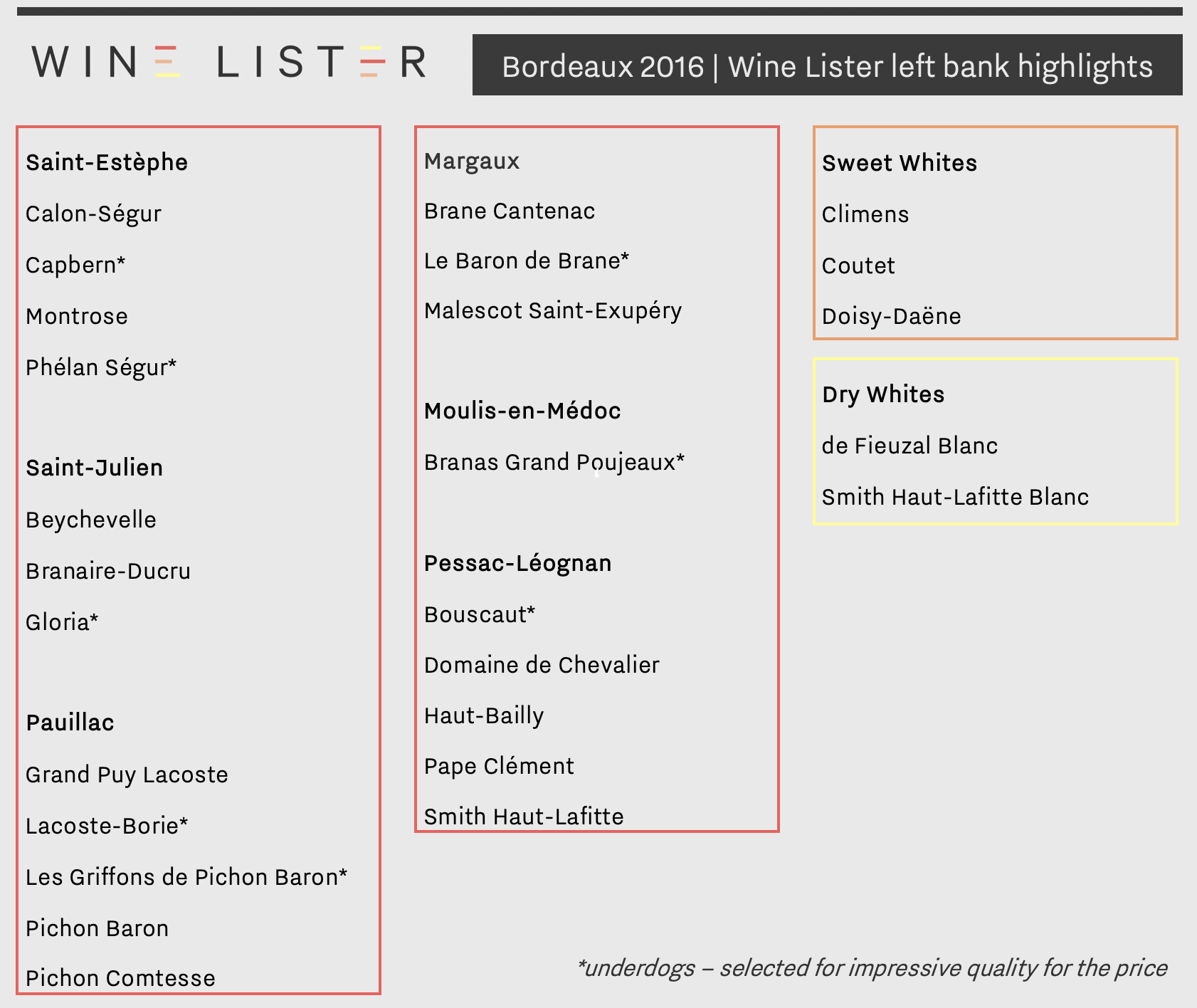 N.B. The tasting did not include first growths, or wines such as Cos d’Estournel, Palmer, Léoville Las Cases, Ducru Beaucaillou, and Pontet-Canet.
N.B. The tasting did not include first growths, or wines such as Cos d’Estournel, Palmer, Léoville Las Cases, Ducru Beaucaillou, and Pontet-Canet.
The spread of favourites from across left bank appellations reflects the homogeneity of the 2016 vintage overall.
Saint-Estèphe was a standout appellation in 2016. Two top dogs, Calon-Ségur and Montrose earned significant praise – Calon is described as having “ballet slipper poise” and a “core of energetic fruit”, where Montrose appeared “elegant, silky and delectable”, with a much-improved integration of oak than the en primeur sample. Beside these sit two underdogs, Capbern and Phélan Ségur, which punch above their expected qualitative weight.
Saint-Julien earns three picks, with Beychevelle being a particular highlight, hailed “ravishing, with vitality and a satin finish”. In Pauillac, Pichon Baron and Pichon Comtesse were both notable, with the former appearing “refined, aristocratic and accomplished”, the latter “exciting, racy, and moreish”. Both Brane-Cantenac and Malescot Saint-Exupéry brought signature Margaux elegance to the tasting mix.
Pessac-Léognan reds were showing particularly well, earning an equal number of highlights as powerhouse Pauillac overall. Haut Bailly made the cut alongside Domaine de Chevalier, Pape Clément and Smith Haut-Lafitte. Bouscaut stood out as the underdog of the Graves.
A few further surprises arose across red appellations, including Gloria, Lacoste-Borie (the second wine of Grand-Puy-Lacoste), and Branas Grand Poujeaux.
Less surprising was the high quality of sweet staples, Climens, Doisy Daëne, and Coutet. Of dry whites, the stand-outs were Smith Haut-Lafitte Blanc (labelled “tonally a step above”), and de Fieuzal Blanc.
Other wines featured in the Bordeaux 2016 left bank highlights are: Branaire-Ducru, Le Baron de Brane, and Les Griffons de Pichon Baron.
While Bordeaux may be best-known for its red blends, many a left-bank cru classé also produces a dry white, particularly in Pessac-Léognan. This week we examine the five most expensive dry white Bordeaux wines.
Whilst each of the five frequently stands in the shadow of their red counterpart (or flagship sweet white in the case of Y d’Yquem), their average price is in fact 28% higher (£260 vs £203). This is presumably due to the dry whites being produced in considerably smaller volumes than their red/sweet white counterpart (just 10% on average).
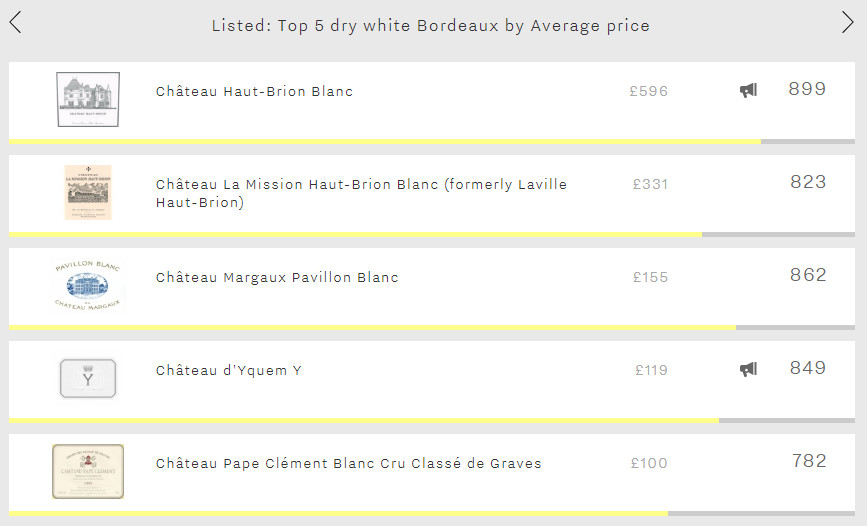
Leading the way is Haut-Brion Blanc at a cool £596 per bottle in-bond, 78% more expensive than Bordeaux’s second-most expensive dry white – its neighbour La Mission Haut-Brion Blanc – and well over three times the average price of the remaining wines in this week’s top five. Whilst its very low production, almost identical to La Mission Haut-Brion Blanc’s and thus the joint-lowest of the five, undoubtedly plays a part in its high price, the fact that it achieves the group’s best Quality and Economics scores (923 and 890 respectively) will also be a contributing factor. Aside from high ratings from each of Wine Lister’s partner critics, its excellent Quality score is also thanks to an average wine life of 10.3 years – the longest of all dry Bordeaux whites on Wine Lister. Indeed, the 2014 vintage, Haut Brion Blanc’s best ever with a Quality score of 975, “should drink well for years and perhaps even decades to come”, according to Antonio Galloni.
Next comes La Mission Haut-Brion Blanc at £331 per bottle in-bond. Relabelled in 2009, this was formerly Laville Haut-Brion. The 2011 is its best vintage since its relabelling, achieving an outstanding Quality score of 974, with Jancis Robinson – who tends to award it her highest scores of the group – calling it “one of the best Bordeaux 2011s”.
In third place is Margaux Pavillon Blanc (£155 per bottle in-bond). Whilst still priced considerably below the whites from Haut-Brion and La Mission Haut-Brion, it is closing the gap, courtesy of vastly stronger growth rates, with a three-year compound annual growth rate of 18% and having added 6% to its value since May. Over both the long and short-term, the two Pessac-Léognan whites have each grown at under half the rate of Pavillon Blanc.
Y d’Yquem is Bordeaux’s fourth most-expensive dry white, at an average price of £119 per bottle in-bond. Boosted by the immense clout of the château’s flagship sweet wine – which enjoys the joint-best Brand score of any wine on Wine Lister (999) – it has the strongest brand of this week’s top five (894). It does so thanks to featuring in the greatest number of the world’s best restaurants of the group (15%), just managing to nudge ahead of Haut-Brion Blanc (12%).
We return to Pessac-Léognan for Bordeaux’s fifth most-expensive dry white, Pape Clément Blanc (£100 per bottle in-bond). The 2017 was its best ever vintage, achieving an excellent Quality score of 903. Whilst it wasn’t quite able to match the scores of Haut-Brion and La Mission Haut-Brion (931 and 939 respectively), it represents considerably better value. At £100 per bottle, it is around one fifth the price of its Pessac-Léognan rivals.
Wine Lister Indicators are designed to help you find the perfect fine wine for any occasion. Wine Lister regularly tracks the movements of wines in and out of these segments (such as recent commentary featuring new Buzz Brands for Burgundy). This month we look at newcomers to the Value Pick segment – wines that achieve the best quality to price ratio.
France is the geographical victor of new Value Picks, with a total of seven wines hailing from Bordeaux and the Rhône (and one from the Loire). These traditional regions may appear “uncool” compared with the likes of Burgundy (whose popularity continues to rise). However, it is perhaps thanks in part to their “uncool” status that Bordeaux and the Rhône are also sources of exceptional value for money.
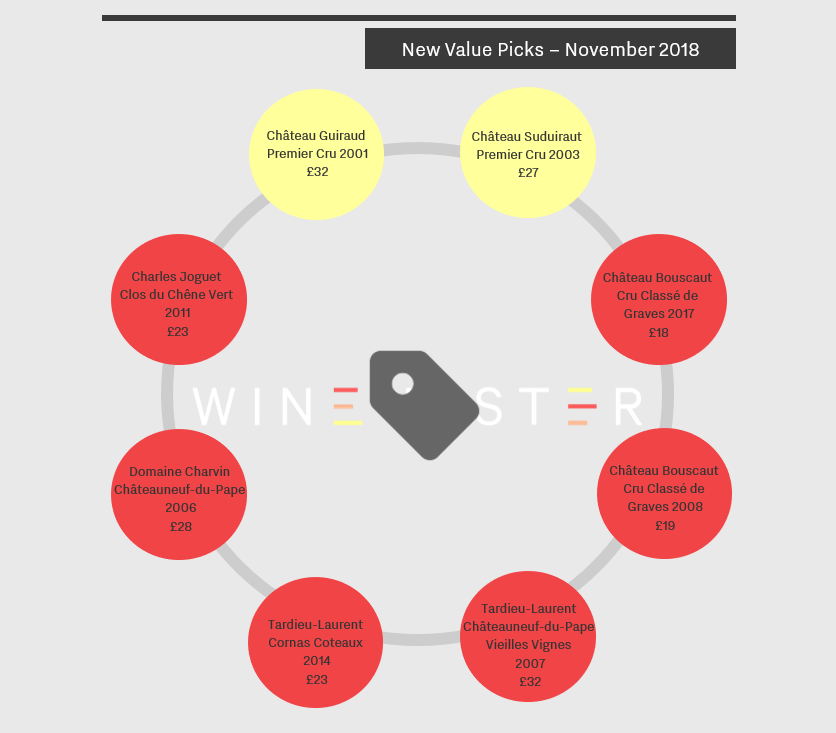
The only two whites of our new Value Picks, Château Guiraud Premier Cru 2001 and Château Suduiraut Premier Cru 2003, actually achieve the highest Quality scores of the group (936 and 929 respectively). Château Guiraud 2001 is priced at £32 per bottle in-bond, and Château Suduiraut 2003 at £27. Sadly, the incredible Quality scores of these Sauternes (as well as others across the board) may be hindered by a lack of demand for the volume produced. Sauternes typically earn poor Economics scores on Wine Lister (Château Guiraud 2001 achieves an Economics score of 212, and Château Suduiraut 2003 345), perhaps due to the pace at which older vintages of these exceptional sweet wines are consumed. With Christmas just around the corner, however, there is every reason to source either of these two for good value for your buck.
Elsewhere in Bordeaux, Pessac-Léognan rules the Value Pick reds with two listings from Château Bouscaut. The 2017 is one of Bouscaut’s new Value Pick vintages, however the real appeal, with 10 years of age, is the physical 2008 vintage, which achieves a Quality score of 768 (vs. 775 for 2017) for a price just £1 above the latest release (at £19 per bottle in-bond). These two vintages join existing Value Picks of Château Bouscaut, namely the 2016, 2015, 2013, and 2004. The latter is interestingly Bouscaut’s highest-scoring vintage ever (868), and therefore provides exceptional value at £21 per bottle in-bond.
In the Rhône, producer Tardieu-Laurent has two newcomers to the Value Pick segment: Châteauneuf-du-Pape Vieilles Vignes 2007 (£32) and Cornas Coteaux 2014 (£23), with Quality scores of 906 and 813 respectively. The Châteauneuf-du-Pape Vieilles Vignes now has an impressive six Value Pick vintages, and the Cornas Coteaux four. Indeed, Tardieu-Laurent (which was recently acquired by EPI, the owner of top Brunello producer Biondi-Santi and both Piper and Charles Heidsieck) appears a good producer to choose for value, with six of the domaine’s ten wines on Wine Lister having vintages in the Value Pick segment. It is perhaps therefore surprising that its Brand scores sit mostly in the average section of Wine Lister’s 1,000-point scale or below – uncool, but with very cool price to quality ratios.
A second Châteauneuf-du-Pape, the 2006 from Domaine Charvin is the third wine from the Rhône to make it to the list, with a Quality score of 869 and available at the modest price of £28 per bottle in-bond.
These French Value Picks convince us that “old-school” wines should not be dismissed as such. With an average price of £25 per bottle in-bond, and an average Quality score of 858, these represent excellent value for money – and that will always be cool.
This week some of the Wine Lister team attended the Institute of Masters of Wine‘s Annual Claret Tasting, which this year focused on Bordeaux’s 2014 vintage. Though still young, it is a vintage that is tasting beautifully.
Throughout Wine Lister’s coverage of this year’s en primeur campaign, we found ourselves referring frequently to the 2014 vintage for comparative (and sometimes better) quality, and crucially, better prices. Below we explore the vintage in more detail, looking at Quality and Economics scores by appellation. (Note that this analysis was produced based on the basket of wines represented at the IMW Tasting).
Wine Lister’s holistic and dynamic approach allows us to not only see which appellations produced the vintage’s best wines, but also demonstrates if and how the market has since reacted to each appellation’s relative quality.
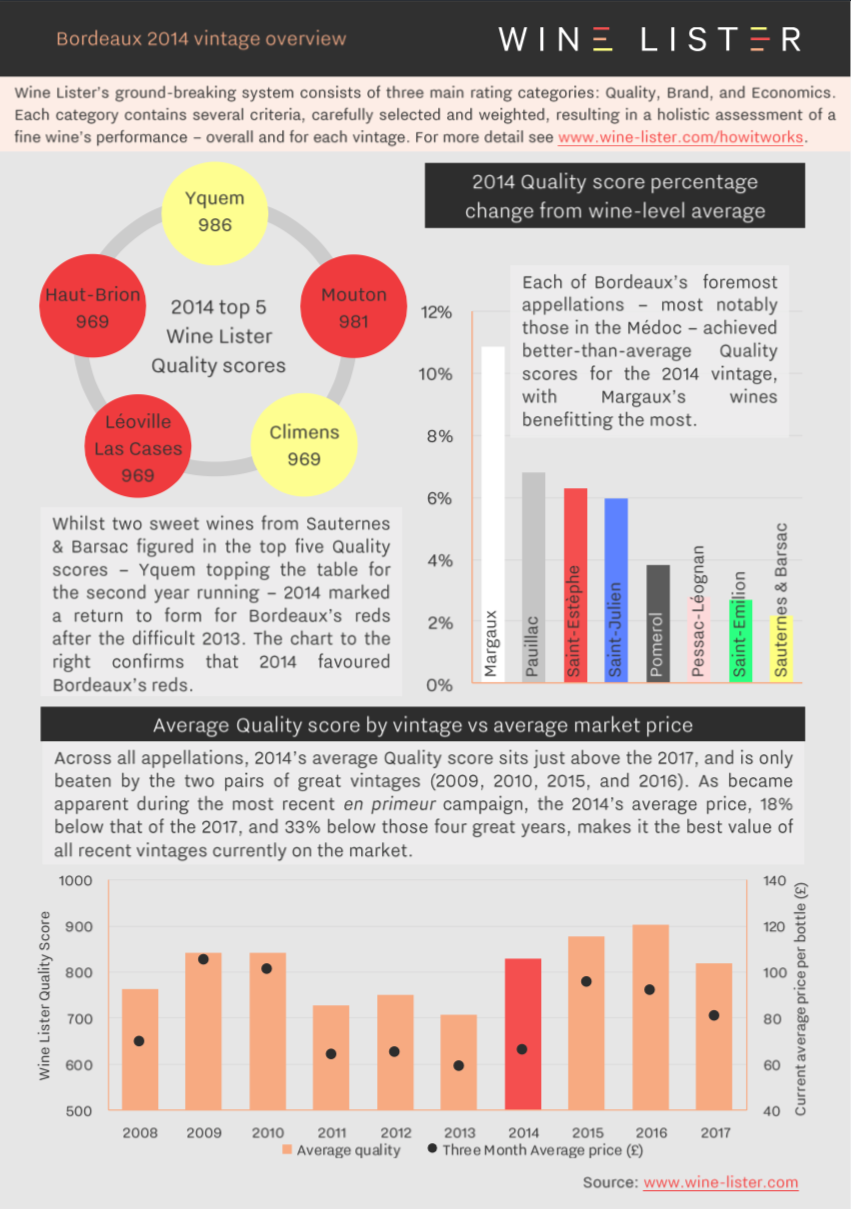
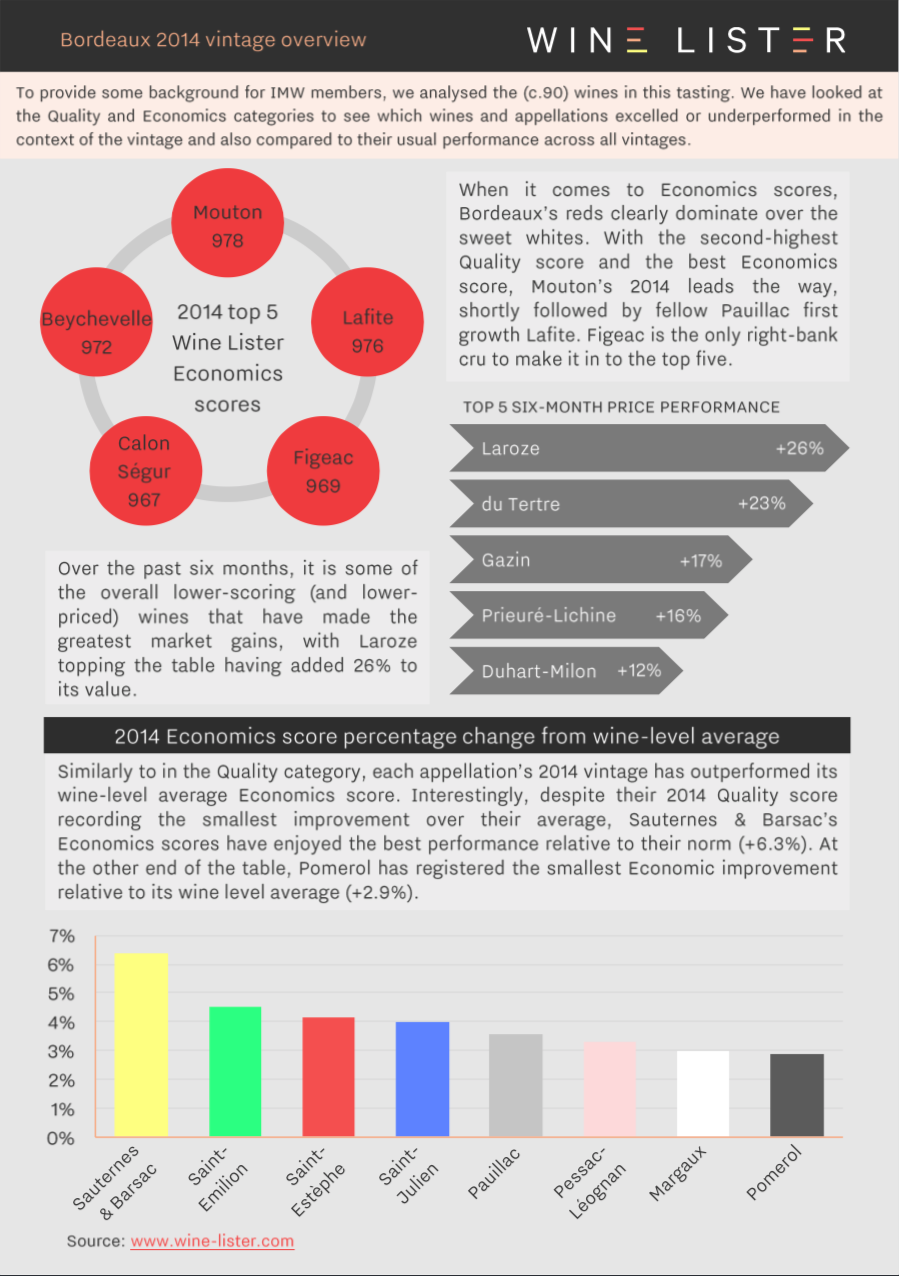
You can download the slide here: Wine Lister IMW 2014 vintage overview
Last week we revealed the top 20 gainers in presence in the world’s best restaurants over the past 12 months. That was in terms of breadth, i.e. the number of restaurants in which a wine features. Wine Lister also analyses the depth of presence – the range of vintages and/or bottle formats of each wine therein. Here we look at the top 21 wines achieving the largest increases in restaurant presence depth since last year.
In first place, with an impressive 35 additional vintages and/or bottle formats listed across the world’s 150 best restaurants since this time last year, is Vega-Sicilia’s Unico. This brings its total references to 250 (almost three and a half in each of the 71 lists in which it features). Given Unico’s average drinking life span of 13 years, and its reputation for longevity (an Unico vertical tasting is an opportunity not to be missed), this result is hardly surprising. Its strong restaurant presence is matched by online popularity (Unico is the 33rd most-searched-for wine in our database), resulting in a Brand score of 992 – the best of any Spanish wine on Wine Lister.
Though Spain takes the number one spot, Italy is the overall biggest mover in increased depth of representation, claiming 12 out of the 21 places shown on the chart below.
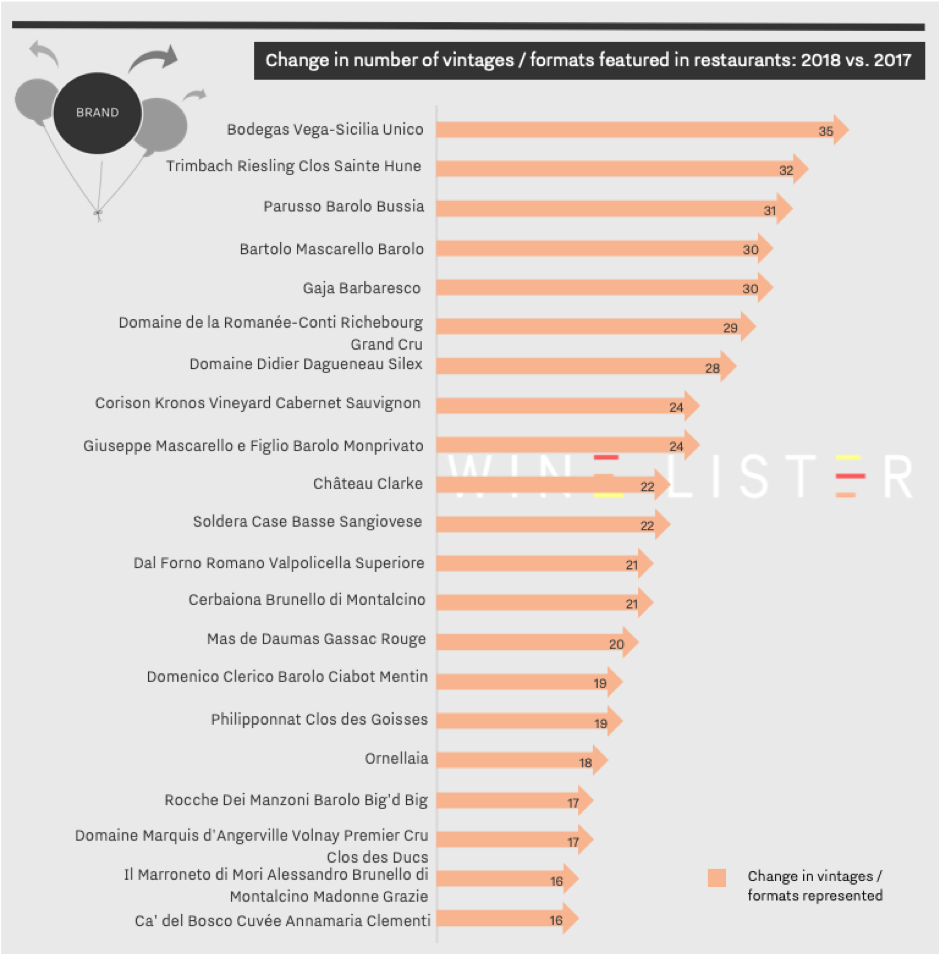
Ornellaia is among these, and is also the most thoroughly represented wine of the group, with 280 vintages and/or bottle formats featured across 43% of the world’s best restaurants.
Several others – Cerbaiona Brunello, Dal Forno Romano Valpolicella Superiore, Ca’ del Bosco Cuvée Annamaria Clementi, and Domenico Clerico Barolo Ciabot Mentin – feature in the top gainers for horizontal as well as vertical presence in the world’s best restaurants. The latter is one of five Barolos to feature in the chart above, joined by Parusso Barolo Bussia, Bartolo Mascarello’s Barolo, Giuseppe Mascarello e Figlio Barolo Monprivato, and finally, Rocche Dei Manzoni Barolo Big’d Big, which sees the biggest increase in vertical presence of the whole group. Despite a horizontal representation increase of just 1%, the number of vintages and/or bottle formats listed across the 3% of the world’s best restaurants in which it features has grown from two to 19 in the last 12 months (or in other words, by 850%).
Outside Italy, the overall picture of restaurant presence depth somewhat contradicts that of breadth painted last week. Though Champagnes, and in particular grower offerings, have increased significantly in terms of horizontal presence, their vintage and/or format gains have not been sufficient to make this week’s top 20. This suggests that whilst sommeliers are keen to add more variety of Champagne, they aren’t so worried about listing reams of vintages / formats thereof. Only one Champagne features in the group: Philipponnat’s Clos des Goisses.
Bordeaux is conspicuous by its absence in this list, other than Château Clarke, with 26 overall references up from just four. In fact, Bordeaux’s big names are more likely to find themselves at the very bottom of the list, many having seen their vertical entries on restaurant wine lists shrink significantly. This seems to suggest that as restaurants diversify, they are choosing to hold less Bordeaux stock, still listing the top wines, but not necessarily in multiple vintages or formats.
With just over eight weeks to go until Christmas, part of the pre-season ritual of any respectable wine lover is surely agonising over which wines to drink with the holiday meal. Whether that means digging into the cellar or making new purchases, perhaps this week’s top five can provide some inspiration. Since claret is a frequent feature at the Christmas table, this week we consider the best red Bordeaux under £50 by Wine Lister score (although note that prices are based on the per bottle average of in-bond case prices across vintages).
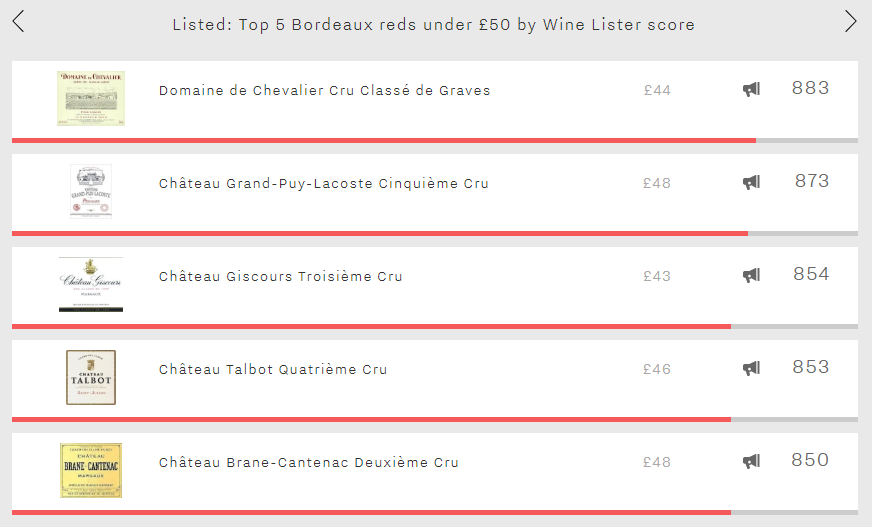
Each of this week’s top five are Buzz Brands, with every wine earning its best score in the Brand category. They also all hail from the left bank, and achieve an average Wine Lister score of 863, 75 points higher than the right bank’s top reds under £50 (788).
First of this week’s top five both overall and for Quality is Domaine de Chevalier, with scores of 883 and 885 respectively, and an average price of £44 per bottle. Though its most qualitative vintage (2015) is only just physical, and therefore not suitable for drinking straight away, there are plenty of vintages around the same in-bond per-case price point to choose from. For example, the 2011 holds a Quality score of 864 and a price of £36, and the 2008 a Quality score of 855 for £40.
Next on the list is Grand-Puy-Lacoste, with a Wine Lister score of 873, and coming in at £48 on average. The 2014 Grand-Puy-Lacoste provides by far the best Quality to price ratio of recent vintages, with a Quality score of 946 and an in-bond per-case price of £41 per bottle. Wine Lister partner critic Neal Martin awards it 95 points, and notes, “the purity and elegance of this Pauillac cannot be denied – a quite brilliant contribution to the 2014 vintage”. This is a wine to give to a loved one for Christmas for them to stow away and open several years down the line – its drinking window ranging from 2022 to 2040.
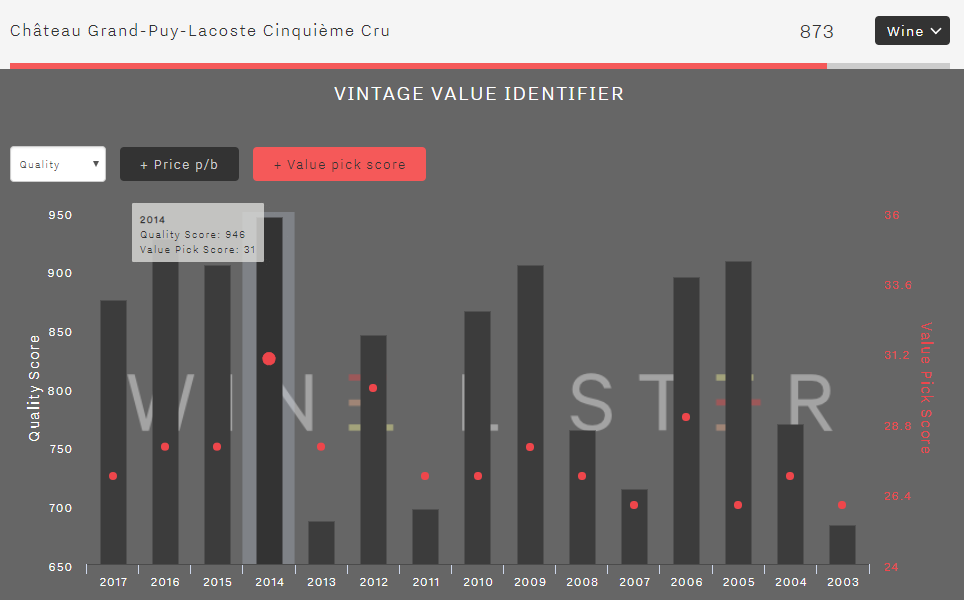 To view quality to price ratios for every wine on Wine Lister, on each wine page use the Value Pick score on Vintage Value Identifier charts, as above.
To view quality to price ratios for every wine on Wine Lister, on each wine page use the Value Pick score on Vintage Value Identifier charts, as above.
Wines three, four, and five of this week’s Listed blog stand within a mere four points of each other. The two Margaux wines to feature, Giscours and Brane-Cantenac, achieve Wine Lister scores of 854 and 850 respectively, and have an identical Quality score (804). However, their profiles differ elsewhere, Brane-Cantenac being the better performer for Economics (806 vs 791), whereas Giscours excels for Brand strength (956 vs 934).
Sandwiched between the two in this week’s top five line-up is Talbot, which claims the group’s highest Brand score (984), if also the lowest Quality score (748), and an average price of £46.
A final commonality of all five wines (and of course of top Bordeaux red as a whole) is the long ageing potential. These five left bank reds have an average drinking window of 13 years, with some more recent vintages expected to be drinking well until beyond 2040 – testament to the tradition of buying claret to lay down for life, and not just for Christmas.
As ripe, healthy grapes are being picked across Bordeaux, winemakers are anything but shy about the potential of the 2018 vintage. “2015 and 2016 are five-star vintages, but 2009 and 2010 are five-star plus,” said Olivier Bernard, president of the Union des Grands Crus Classés de Bordeaux. At his own property in Pessac-Léognan, Domaine de Chevalier, “2018 has 2009-2010 potential,” he declared on Wednesday morning, just as the red harvest was beginning.
Bernard is not the only Bordeaux producer daring to hope that the region has another great vintage on its way into the cellars. Part of the Wine Lister team is just back from four days in Bordeaux, where we visited châteaux on right bank and left, from Saint-Estèphe in the very north to Pessac-Léognan south of the city. We tasted lots of berries, spoke to oenologists, and even picked some grapes.
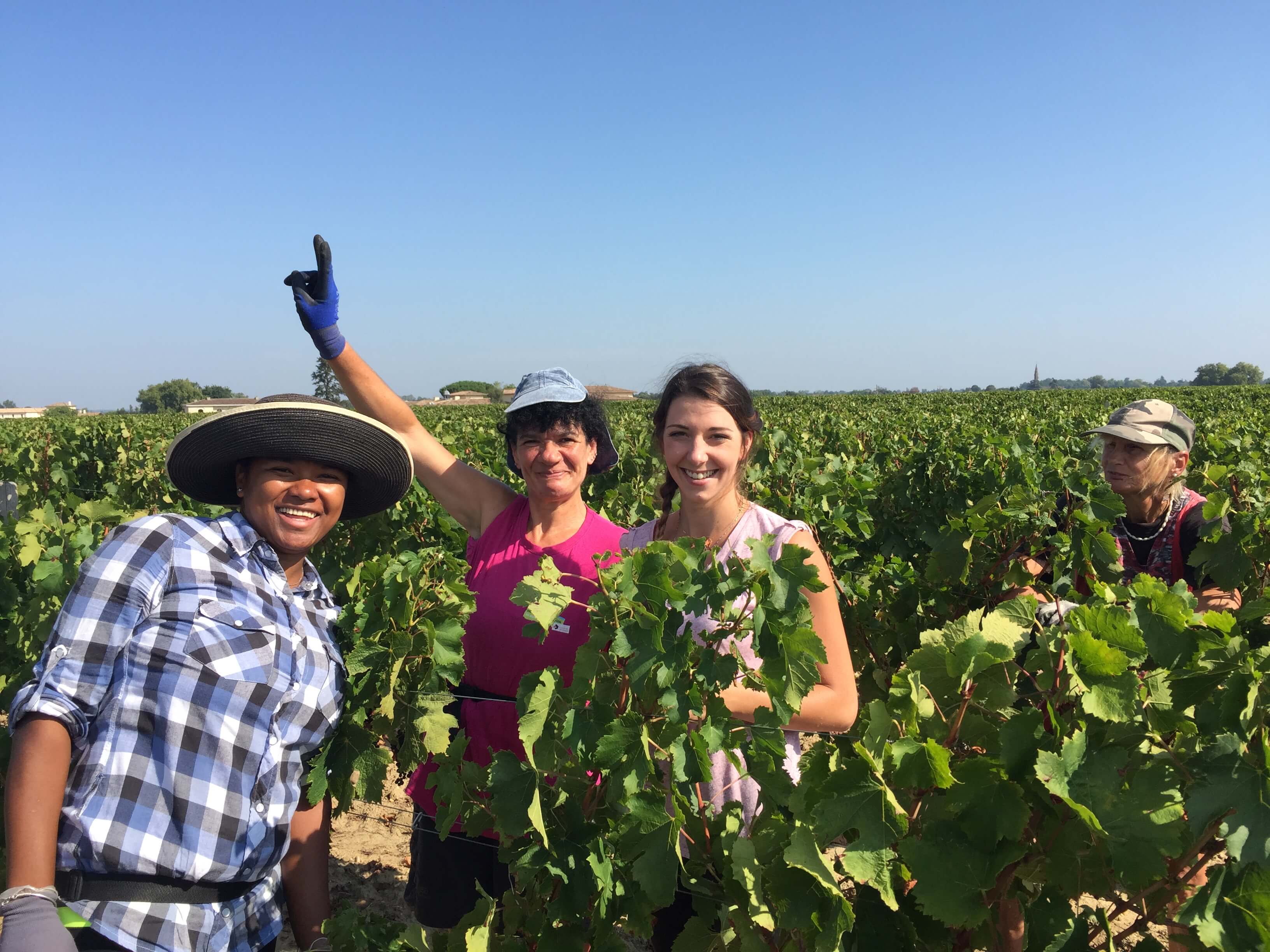
Members of the picking team at Petrus during the 2018 harvest
Producers’ smiles were big, and all the signs were promising, but after such a rollercoaster growing season, can 2018 really match up to the historic pair of 2009 and 2010? I asked straight-talking winemaking consultant Stéphane Derenoncourt if this comparison was justified. “More 2010,” he confirmed, adding, “There are going to be some delicious wines.”
Spring in Bordeaux was interminably wet, and mildew a serious threat throughout the region. “We thought there might not be a harvest at all,” recalls Nicolas Audebert, Managing Director of Châteaux Canon and Rauzan-Ségla. “It rained non-stop, and with high humidity and the high temperatures in June, it was almost tropical,” he said. Some members of Audebert’s team had never seen mildew so rife in 40 years of working the vines in Bordeaux.
Many top producers were affected, especially those practising organic or biodynamic viticulture and therefore unable to treat the vines systematically to protect from the fungus. In Saint-Estèphe, at the top of the Gironde Estuary nearest the Atlantic Ocean, Lafon-Rochet, organic since 2010 (though uncertified), abandoned the practice this year, and for good, in order to fight the rain.
However, mildew “is primarily a problem for quantity, rather than quality,” explained Axel Marchal, consultant and researcher at Bordeaux University, because the affected grapes are easily removed and discarded. “Badly hit vines can see a slight quality impact too, if the stress caused to the plant is enough to delay maturity,” he clarified.
At Canon in Saint-Emilion, quantity lost to mildew was recouped by less green harvesting later in the season. Its larger Margaux sister property, Rauzan-Ségla, was not so lucky, and yields will be lower than average. The two properties are organic (again not certified), allowing them to treat the vines when “really necessary”. However, many strictly organic or biodynamic estates will produce much smaller quantities of wine this year, meaning yields will be very varied from château to château, ranging from around 15 hl/ha to 50 hl/ha or more.
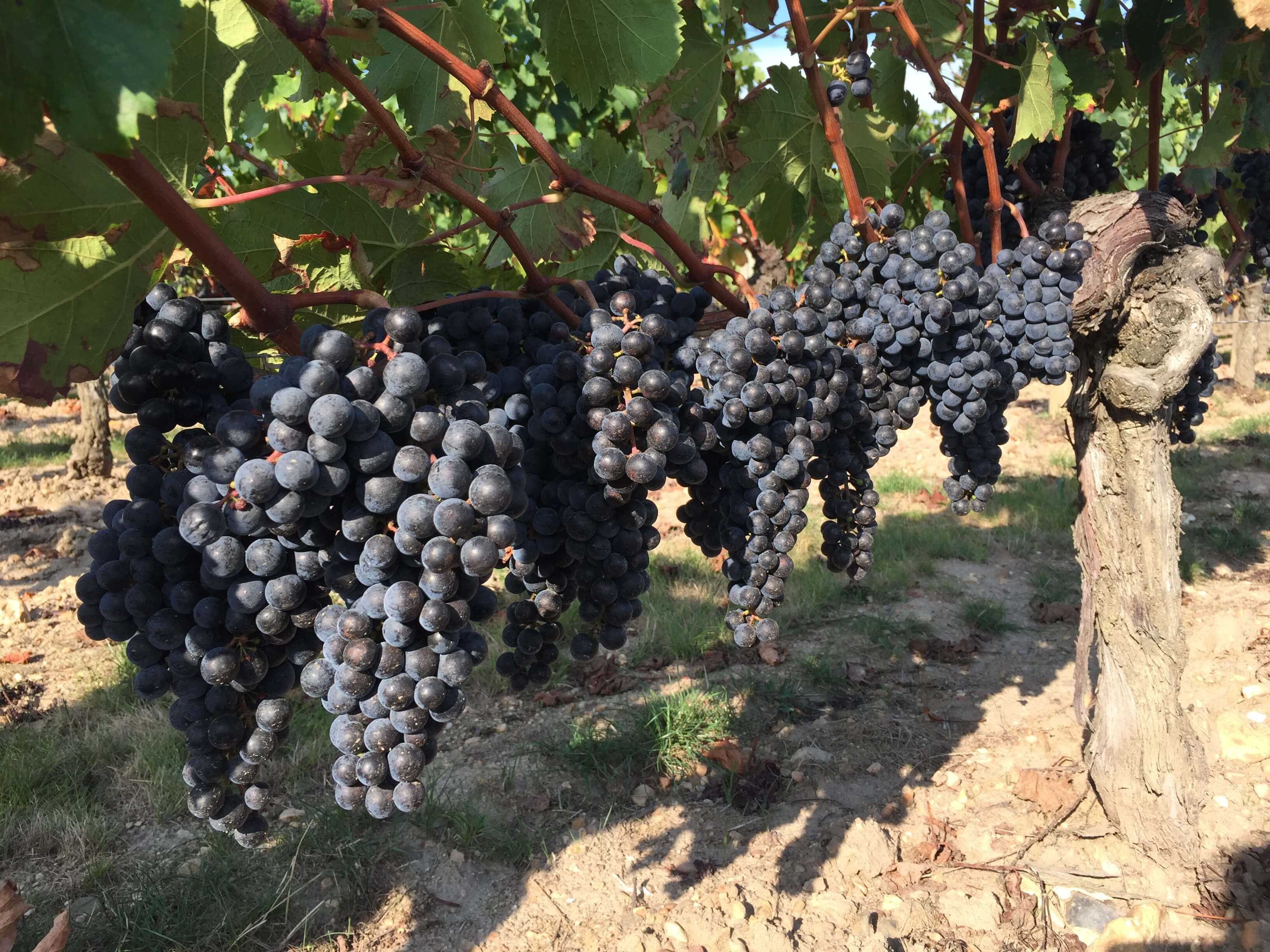
Grapes ripe for picking at Petrus
Potential quantity started off high, with the rain acting as “a signal for the plant to produce lots of fruit,” explained Bernard. The incessant spring downpours had another positive effect: they left the ground full of water, helping the vines to withstand the hot, dry summer that unfolded from 20th June onwards. “Looking at our vines, it’s hard to believe it’s been one of the driest summers in 50 years,” marvelled Bernard.
Audebert thinks the 2018 Canon will be soft and rounded, but livelier than 2005 or 2009, with phenolic potential above that of the 2010 (which of course is renowned for its intense colour and high levels of ripe tannin). When I asked if it could be as good as 2010, my question was met with silence and a roguish smile.
As part of our Brand score, Wine Lister measures popularity using the three-month rolling average searches on the world’s most visited wine site, Wine-Searcher.
We have recently updated our treatment of this data to provide relative results for all 4,000+ wines on Wine Lister. Expressing each wine’s search frequency as a ranking will make it easier for our users to interpret the data. For example, Mouton is the #1 most searched-for wine of all wines on Wine Lister, according to monthly searches on Wine-Searcher.
To mark this transition, here we examine the top 50 most popular fine wines in the world.
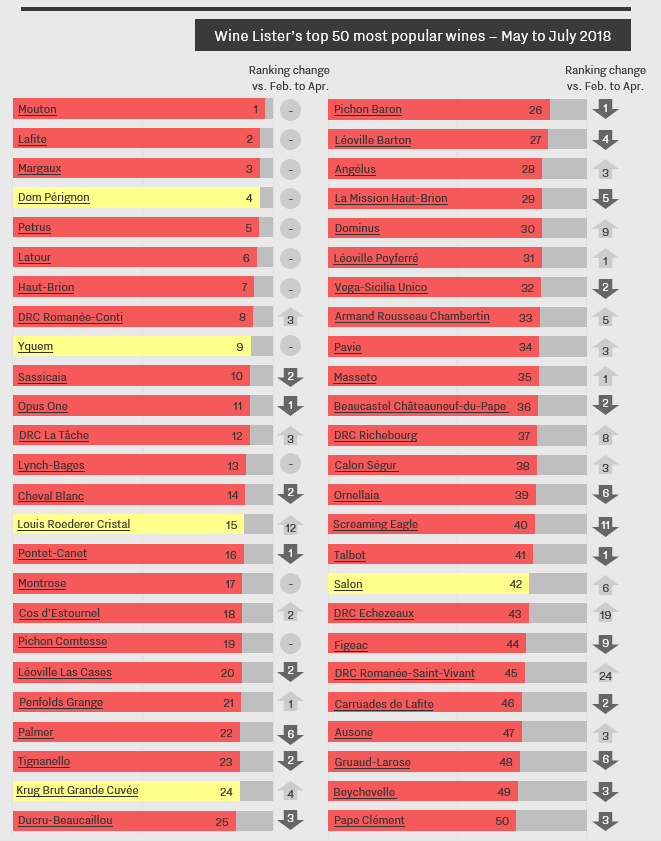
The first seven most searched-for wines for the period of May, June, and July include the five Bordeaux left bank first growths (Mouton, Lafite, Margaux, Latour, and Haut-Brion), right-bank powerhouse, Petrus, and Champagne super-brand, Dom Pérignon. It is perhaps of no surprise that these rankings remain unchanged since the previous period (February to April) .
Burgundian searches in the top 50 are dominated by Domaine de la Romanée-Conti, with Romanée-Conti, La Tâche, Echezeaux, and Romanée-Saint-Vivant all achieving better rankings versus the previous period. These four together achieve an average ranking of 30th place, and an average movement up the search ranking of 11 places.
Other than Dom Pérignon, the two remaining Champagnes featured in the top 50 most searched-for wines have moved up the rankings for May-July 2018 compared to the previous three-month period. Louis Roederer’s Cristal was up 12 places, presumably due to the release of its 2008 vintage in June. Krug’s most recent Grande Cuvée (166th edition) was released in late May, explaining its jump four spots up the rankings into 24th place.
More than half of the top 50 most popular wines are Bordeaux, with 30 wines hailing from the region. However, Bordeaux did not see the boost to their search ranking one might have expected during Bordeaux’s en primeur 2017, with one fewer of the region’s wines featuring in the top 50 than before the campaign kicked off. In fact, supporting Wine Lister’s analysis of this year’s lacklustre campaign, searches for many top Bordeaux châteaux actually fell during this period. For instance, Figeac, despite achieving Bordeaux’s 10th best Quality score of the 2017 vintage, slipped nine spots down the rankings.
As the Place de Bordeaux reawakens for September releases this week, Wine Lister examines some “place-distributed” wines from closer to home, namely the top five Bordeaux third growths by Wine Lister score. The successful 2009 and 2010 vintages in Bordeaux helped to coin the term “super seconds”, and despite a trickier en primeur campaign this year, these five wines make a good case for a new term: “thrilling thirds”.
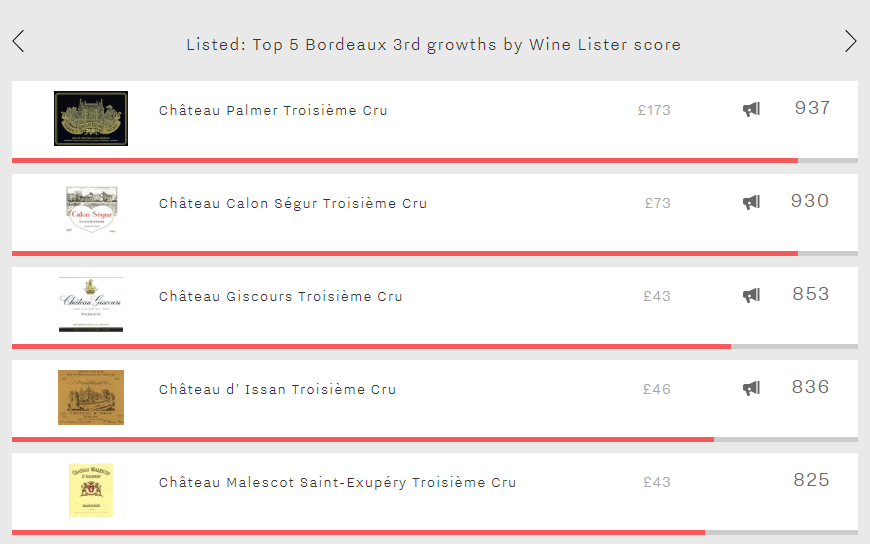
In first place, and one of the first out of the blocks for en primeur this year, is Palmer. With an overall score of 937, it is not only the best of this week’s top five, but also sits 69 points ahead of the average Bordeaux second growth Wine Lister score. Aside from its impressive Quality score (909), Palmer’s strength lies in its Brand, with a score of 995, thanks to presence in 47% of the world’s best restaurants, and being ranked 22nd out of all wines on Wine Lister for searches on Wine-Searcher.
Calon Ségur comes in second place, with an overall score of 930. It is the only Saint-Estèphe with third growth status, and the only one of this week’s top five not from Margaux (unsurprising, given that 73% of all Bordeaux left bank third growths hail from the appellation). Calon’s Economics score of 941 is the fifth-best of all Bordeaux left bank reds (beaten only by Carruades de Lafite, Château Margaux, Lafite, and Mouton). This is achieved through a three-year compound annual growth rate of 17% and short-term price performance of 8% – both the highest of this week’s top five.
Giscours is next with an overall score of 853. While Brand is its strongest score category (956), its Quality and Economics scores (804 and 782 respectively) still sit within the “very strong” section of the Wine Lister 1000-point scale. Furthermore, alongside Lynch Bages, Giscours was voted the most consistent seller (in volume terms) by the Place de Bordeaux in our 2018 Bordeaux Market Study.
The last two places of this week’s top five are taken by d’Issan in fourth place, and Malescot Saint-Exupéry at number five with scores of 836 and 825 respectively. The latter is the only one of this week’s top five that is not a Wine Lister Buzz Brand. As the least-known of the five, it might be considered the best value, with a Quality score of 811 and an average price of £43.
This week’s top five require absolutely no introduction. As Buzz Brands – Wine Lister’s group of wines that achieve outstanding online popularity and restaurant presence, and are also identified by the global fine wine trade as trending or especially prestigious – that is perhaps a given. Couple that with the fact that they hail from Bordeaux, and are the region’s most expensive Buzz Brands, it would be nigh on impossible for you not to be familiar with them to some degree.
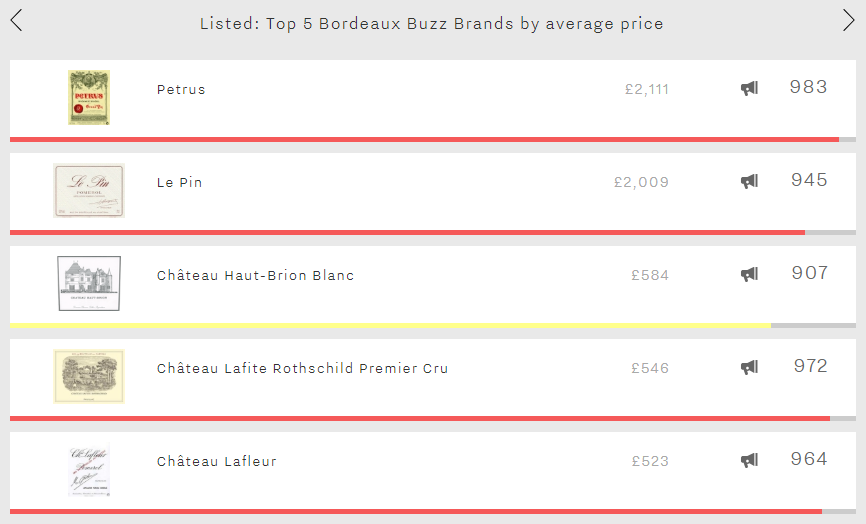
Pomerol is home to three of the five. With the limited production volumes of the plateau’s top wines, it is perhaps no surprise that they reach eye-watering prices. Petrus leads the way with an average price across all vintages of £2,111. It is Bordeaux’s best wine, and the fifth best in the world, its phenomenal score of 983 only bettered by Salon and three (!) DRC cuvées. Petrus is consistently brilliant across Wine Lister’s three rating categories with Quality, Brand, and Economics scores of 978, 998, and 972 respectively. It is worth focusing on its Brand score. Despite its relatively low production volumes, its rate of restaurant presence is outstanding. Visible in 45% of the world’s top establishments, and with more than five vintages / formats featuring on each wine list on average, it is clearly a wine that commands the utmost respect from sommeliers. Moreover, receiving over 60,000 online searches each month, it is well over five times as popular as its Pomerol neighbours Le Pin and Lafleur.
Le Pin comes next (£2,009). It enjoys Bordeaux’s second-best Economics score (979), pipped at the post by Carruades de Lafite (980). Its outstanding score comes courtesy not just of its high price, but also strong price performance, with a three-year compound annual growth rate (CAGR) of 17% and having added 8% to its price over the past six months alone. With those sorts of figures, it will soon overtake Petrus as Bordeaux’s most expensive wine – its neighbour having recorded a three-year CAGR of 13% but only managing to add 4% to its value since March.
At roughly a quarter of the price of Petrus and Le Pin, Lafleur is Bordeaux’s fifth most expensive Buzz Brand (£523). It was Bordeaux 2017’s top red for Quality, its score of 978 putting it just ahead of Petrus (971). Across all vintages it is also the longest-lived of this week’s top five, with Wine Lister’s partner critics predicting an average ageing potential of 21 years.
We cross over to the left bank for the group’s remaining two wines, the first of which might come as a slight surprise. Haut-Brion Blanc is Bordeaux’s third-most expensive Buzz Brand (£584). It is of course its rarity that propels it up the price tables. Producing just 6,720 bottles on average each year – 15 times fewer than Haut-Brion Rouge – it is over 60% more expensive than its red counterpart, despite trailing across each category.
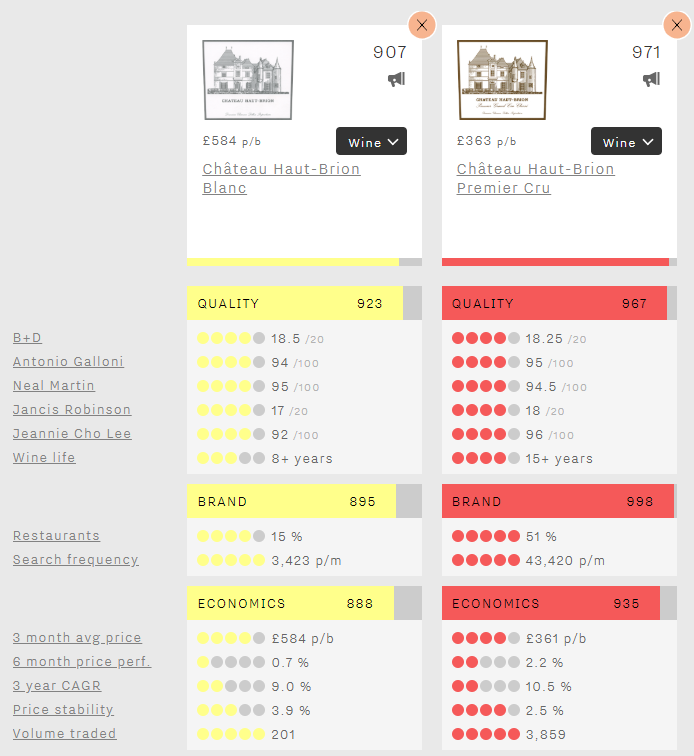
Rounding out the group – if it can ever be described as such – is Lafite (£546). With the best part of 200,000 bottles of it produced each year, it will come as no shock that it manages the best restaurant presence of the five, both in terms of the number of establishments in which it appears (54%) and the number of references per list (6.3 on average). It is also the most popular wine in the world, receiving over 80,000 online searches each month.
 N.B. The tasting did not include first growths, or wines such as Cos d’Estournel, Palmer, Léoville Las Cases, Ducru Beaucaillou, and Pontet-Canet.
N.B. The tasting did not include first growths, or wines such as Cos d’Estournel, Palmer, Léoville Las Cases, Ducru Beaucaillou, and Pontet-Canet.





 To view quality to price ratios for every wine on Wine Lister, on each wine page use the Value Pick score on Vintage Value Identifier charts, as above.
To view quality to price ratios for every wine on Wine Lister, on each wine page use the Value Pick score on Vintage Value Identifier charts, as above.




